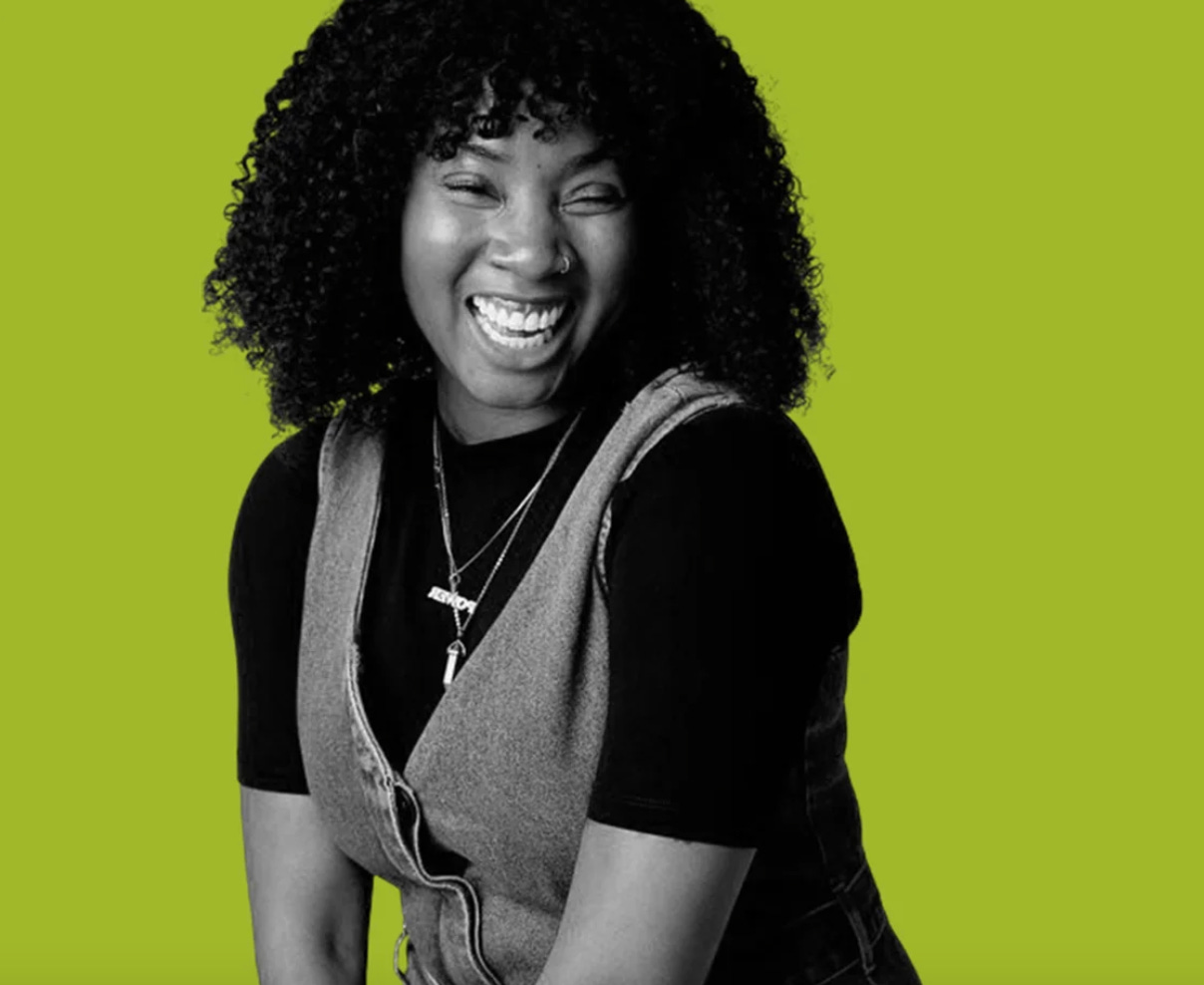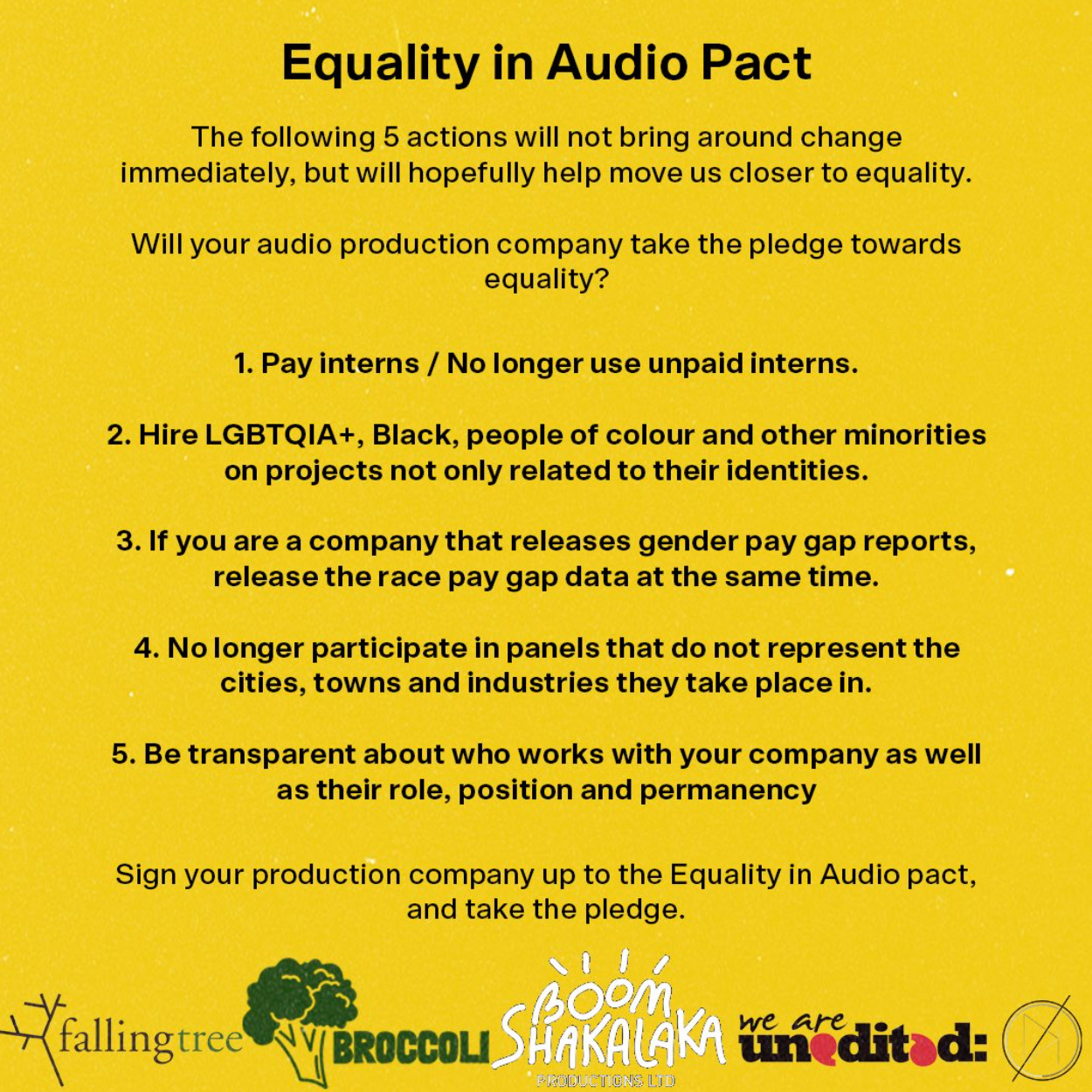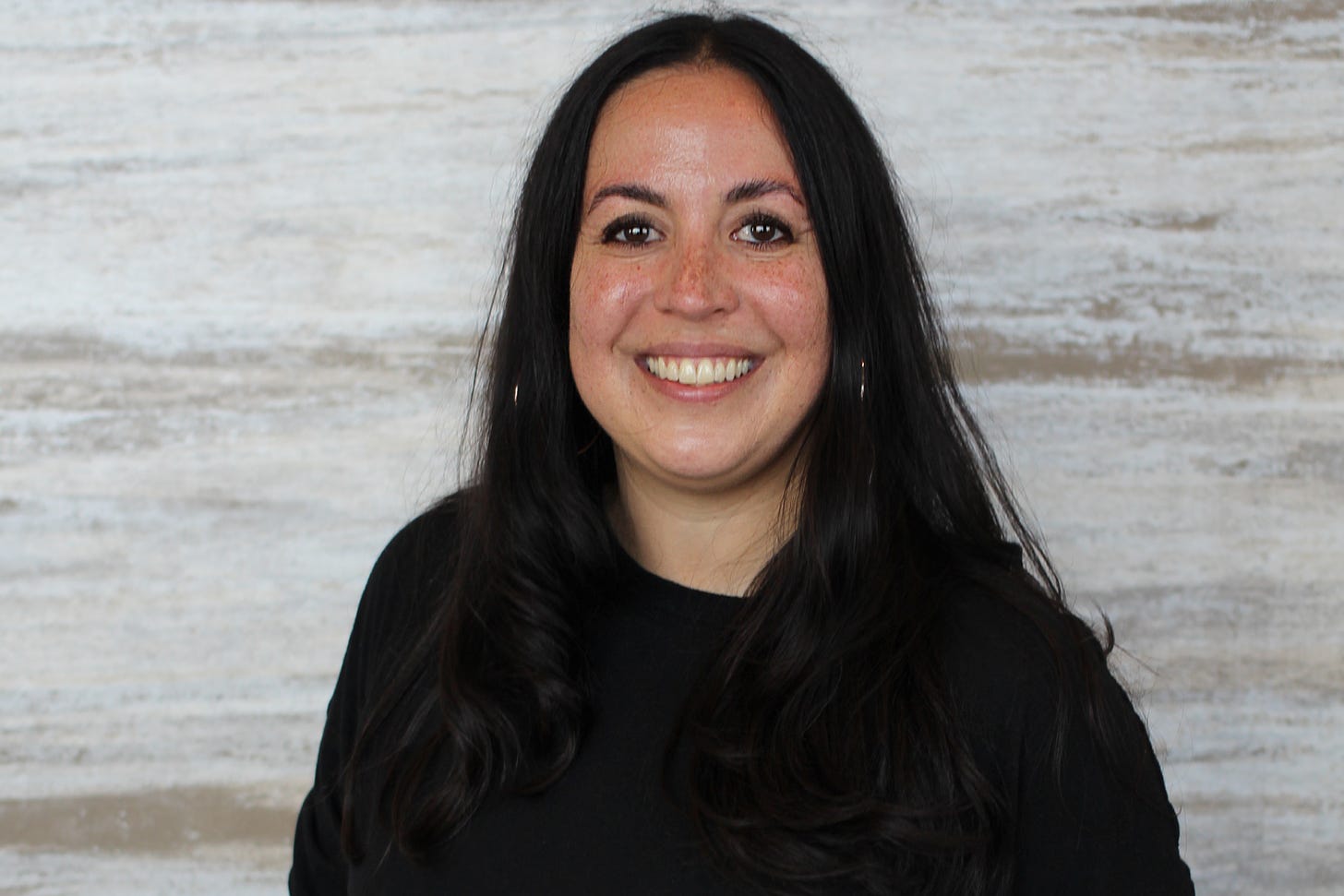Remember the Equality in Audio Pact?
An Update From Its Creator. Plus: An Expert Explains How a Single Shift in Thinking Can Transform an Organization's DEIA Strategy


Hello!
Thanks to everyone who reached out to share your appreciation of my series on PRX. Your words have meant the world to me.
While the overwhelming majority of feedback has been positive, current PRX employee Sandra Lopez-Monsalve, posted a tweet that read, “I appreciate you following up on the story but the way this is presented makes me, a woman on [sic] color working at PRX -1 of many- feel invisible. I think my contributions are not invisible.”

The goal of my reporting is always to get as close to the truth as possible. However, it’s undeniable that in investigative stories like these where reporters don’t interview current employees — or even in stories where reporters don’t speak to every single employee — they can’t possibly include everyone’s truth. All that said, I’ve let Sandra know that I’d welcome a chance to speak with her.
I’m hopeful that I’ll hear from other current employees as well, as I recently received the following note on background from someone else who works at the organization:
C-suite and managers throughout the org have made it very clear on multiple occasions that all employees should feel empowered to reach out and speak to you, so I know for a fact that all PRXers are aware and unafraid of retribution from the org.
No one has come forward yet, but in case anyone is considering it:
We can speak on any platform you like — phone, zoom, WhatsApp, etc.
We can begin by speaking off the record, and if you decide you’d like to speak on the record, or on background, you can make that choice (I won’t put any pressure on you to do so).
As an alternative, you can send me a written note via email or DM. If it adds perspective to the story, I’d be happy to publish it in full, without any edits.
I always honor requests for anonymity.
Finally, please don’t hesitate to ask anyone I’ve interviewed what they think of my integrity as a reporter.
Alright, let’s hit today’s main events:
Broccoli Productions CEO and creator of the Equality in Audio Pact Renay Richardson discusses what happened after hundreds of organizations signed her pact in 2020 (spoiler: not much);
And The Diversity Pledge Institute’s Director of Institutional Research Gaby Martinez-Stevenson explains how a single shift in thinking can transform an organization’s DEIA strategy.
Both interviews have been edited for length and clarity.
In the wake of George Floyd’s murder and the Black Lives Matter protests of 2020, Renay Richardson, founder of UK-based Broccoli Studios (a joint venture with Sony Music), announced that she and her team had created the Equality in Audio Pact. In signing the pact, organizations committed to five actions including paying interns, hiring people of marginalized identities to work on projects unrelated to their identities, and sitting on panels representative of the event’s geography and industry. After two years, we check in on what’s happened since the project launched.
In Her Words: Renay Richardson
Sometimes I think about how I got to my position within this industry.
I grew up and live in England, but the deal I negotiated for Broccoli Productions is with Sony New York. In America I’m considered “a good Black” because I have a British accent. It’s seen as proximity to whiteness. Americans subconsciously see me as someone closer to a white person. Do you know how many Black British people are paid to play Black Americans in the movies and on TV? I’ll give you the answer: loads. Because they’re seen as “good Blacks,” and it’s all because of their accent.
I’m ambitious and hard-working, but still, all my opportunities have come from America. And I haven’t even needed to be in the country! I’m very aware of this.
There are excellent American audio producers who are Black who would never get the opportunities I’ve gotten because they don’t have the accent.
It all comes down to racism.
When the George Floyd murder happened, I looked around and everyone was saying “we hear you, we’re listening and learning.” The Equality in Audio Pact was something we gave to the people so that they could actually do something.
The Broccoli team and I brainstormed five things that we thought everyone could do. For example, hire people of color to work on shows that are not just about race, or decline to be on non-diverse panels.
Loads signed it — around 400 — but almost immediately, people started breaking the pact. I saw bunches of them sitting on all-white panels. Everyone's an ally until the right opportunity presents itself, right? Especially if you’re in a position of power and inequality is already serving you. Now I understand that everyone just wants the applause. Next time I see those people I’ll clap for them! [laughs, slow claps]
I realized that I couldn’t make people do something; they had to want to do something. You can look at the list of signers and see who was all about the online pledge but in real life, complete inaction.
It’s not surprising. The people who were “listening and learning” in 2020 were the same people who had blocked me from opportunities and acted like Black people didn’t exist before that. I’ve been Black my whole life, but you’re just learning that I exist?
These people are still in power. They’re still listening and learning!
As soon as I was born, I was learning. That’s 37 years of learning so far. If you’re my boss, and you’re just starting to learn now, you are decades behind me. You’re learning how to do something that directly impacts me and my work environment. Should you be allowed to stay in your role — where you should already know how to deal with Black people and people of color — when you’re just starting to learn? The answer is no.
Everyone knows what to do on the surface — stick a Black person on a panel, hire a DEI person. But you need to do a lot of other things. You need to make sure that people of color are being hired by other people of color. You need to hire at all levels of the organization. And you need to be able to say when you make a mistake, because hiring a brown face or a black face doesn't always mean progress.
There is so much to be done.
There's a new generation of people who have been invested in — I'm one of them. If I get acquired, I’ll reinvest the money into the industry. I hope the many people who have already made money in audio invest it in a way that changes things, rather than keeping it the way that it has always been.
Gaby Martinez-Stevenson is the Director of Institutional Research at The Diversity Pledge Institute (TDPI) where she’s currently running a long-term survey of news organizations that takes stock of what diversity, equity, inclusion and accessibility (DEIA) practices are and aren’t working. TDPI’s ultimate goal, she told me, is to “help newsrooms implement DEIA practices in a way that isn't piecemeal, but rather, serves as a foundation for the whole organization.” Martinez-Stevenson is currently a doctoral candidate in sociology at the University of Massachusetts, Amherst.
In Her Words: Gaby Martinez-Stevenson
After I graduated from college, I took a job as a bilingual teacher at a Title I school outside of Dallas. We were teaching this very white-based curriculum to a classroom full of children from Mexico and Guatemala.
I was teaching 3rd graders about immigration and Ellis Island and there was a picture of white immigrants on a raft in one of our textbooks. This eight-year-old boy raised his hand and said “they’re not dirty, like I am.” He pointed to the color of his skin. He said that other kids at the school had said his skin was dirty. Meanwhile, he wasn’t seeing himself reflected in anything we were teaching. I don’t know if someone could do this nowadays, but the school gave me the freedom to introduce books that represented the kids in this classroom.
After that I decided to go back to school, but I had already been doing this kind of work a long time. I founded an organization focused on racial justice in my community. And in my job before this one, I worked in health equity.
At the Institute, we’re focused on ensuring that newsrooms are able to diversify in meaningful ways. While we do place journalists in newsrooms, our focus is on retention, more than hiring. We also provide free mentorship for journalists through our Learning Circles program.
As part of the survey work I’m doing, I ask folks to explain how engaging in diversity trainings has changed their everyday work. This is something every person at an organization should know, but so far I can't think of a single employee who’s been able to give me an answer.
To be clear, this is not the fault of the employees; this is happening because companies haven’t integrated their DEIA programming into their values in a way that impacts the day-to-day work of the entire organization. They’ve created a “quota system” instead of a “value system.”
This is the shift companies need to make.
Take hiring. Most organizations are focused on just getting diverse talent in the door, but that should be the last step an organization takes when they’re building out their DEIA model.
Let’s say you set an outcome goal of increasing your organizations’s diversity by 50%. Would you be happy with a revolving door of diverse talent, even if you’re meeting your goal? That’s one way to do it, right? However, if you shift your outcome goals toward retaining those employees, it forces the entire organization — every department — to think about how their practices, policies, etc. can support that effort.
Companies have to build frameworks that will allow them to meaningfully and organically implement DEIA before they begin hiring.
I think it was in part two of your series on PRX where someone said it felt like the diversity work was piecemeal — this gets to this exact issue. If the outcome goals involve the work of the whole organization — if they become part of the organization’s business strategy, content strategy, advertising strategy, etc. — then diversity will happen by default because the organization will need those voices to achieve those goals.
Diversity shouldn’t be something you can count on your hands or something that you can look at and say, look, there’s diversity! You have to create a culture that is not only receptive to, but also safe for those groups, so that they stick around.
A huge element of this is getting buy-in from leadership. [Political economist] Nicole Anand has this great quote: “Hiring for diversity and then managing for assimilation does not breed innovation.” Let’s say your leadership creates a bunch of DEIA committees, but those committees don’t have any real power — leadership can just shut down their recommendations — that’s a sign that the organization has hired hired for diversity but managed for assimilation, not innovation.
Sometimes leadership needs to change — however, for the same reason that you can't diversify by just hiring more people of color, you also can't expect your organization to change just by getting new leadership. The people who replace the leadership are inheriting the same structures, the same culture, the same values as previous leadership. If leadership does step down, the new leadership will need to see changing the culture as an explicit part of their mandate.
Many organizations started with checking boxes and having conversations; now it’s time to move beyond that. The next step is looking at what’s working, what’s not, and leveraging that to make meaningful change.
That’s all for me this week —
See you next Thursday.
Skye






